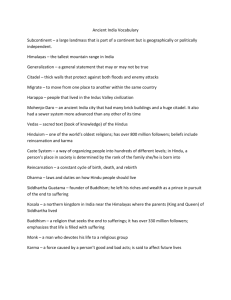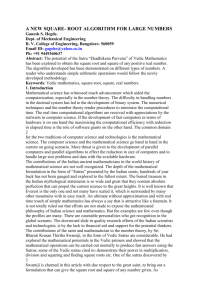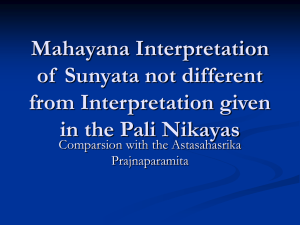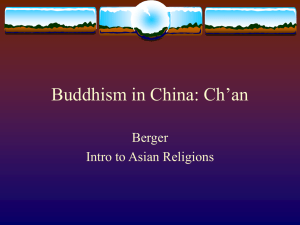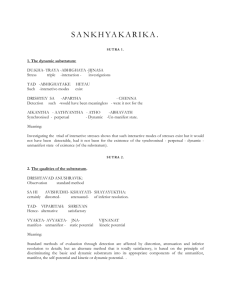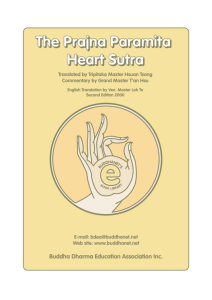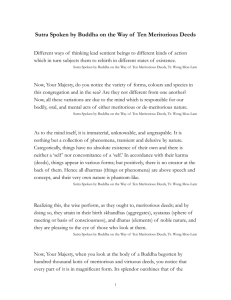Read Transcript - The Engaged Zen Foundation
advertisement
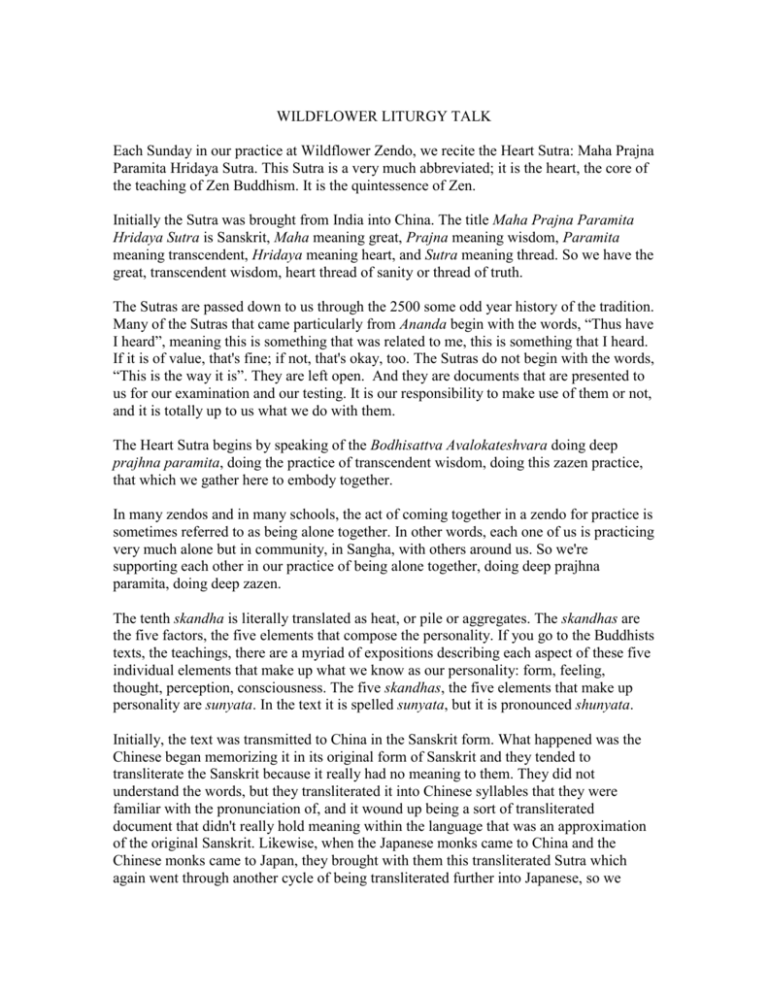
WILDFLOWER LITURGY TALK Each Sunday in our practice at Wildflower Zendo, we recite the Heart Sutra: Maha Prajna Paramita Hridaya Sutra. This Sutra is a very much abbreviated; it is the heart, the core of the teaching of Zen Buddhism. It is the quintessence of Zen. Initially the Sutra was brought from India into China. The title Maha Prajna Paramita Hridaya Sutra is Sanskrit, Maha meaning great, Prajna meaning wisdom, Paramita meaning transcendent, Hridaya meaning heart, and Sutra meaning thread. So we have the great, transcendent wisdom, heart thread of sanity or thread of truth. The Sutras are passed down to us through the 2500 some odd year history of the tradition. Many of the Sutras that came particularly from Ananda begin with the words, “Thus have I heard”, meaning this is something that was related to me, this is something that I heard. If it is of value, that's fine; if not, that's okay, too. The Sutras do not begin with the words, “This is the way it is”. They are left open. And they are documents that are presented to us for our examination and our testing. It is our responsibility to make use of them or not, and it is totally up to us what we do with them. The Heart Sutra begins by speaking of the Bodhisattva Avalokateshvara doing deep prajhna paramita, doing the practice of transcendent wisdom, doing this zazen practice, that which we gather here to embody together. In many zendos and in many schools, the act of coming together in a zendo for practice is sometimes referred to as being alone together. In other words, each one of us is practicing very much alone but in community, in Sangha, with others around us. So we're supporting each other in our practice of being alone together, doing deep prajhna paramita, doing deep zazen. The tenth skandha is literally translated as heat, or pile or aggregates. The skandhas are the five factors, the five elements that compose the personality. If you go to the Buddhists texts, the teachings, there are a myriad of expositions describing each aspect of these five individual elements that make up what we know as our personality: form, feeling, thought, perception, consciousness. The five skandhas, the five elements that make up personality are sunyata. In the text it is spelled sunyata, but it is pronounced shunyata. Initially, the text was transmitted to China in the Sanskrit form. What happened was the Chinese began memorizing it in its original form of Sanskrit and they tended to transliterate the Sanskrit because it really had no meaning to them. They did not understand the words, but they transliterated it into Chinese syllables that they were familiar with the pronunciation of, and it wound up being a sort of transliterated document that didn't really hold meaning within the language that was an approximation of the original Sanskrit. Likewise, when the Japanese monks came to China and the Chinese monks came to Japan, they brought with them this transliterated Sutra which again went through another cycle of being transliterated further into Japanese, so we wound up with a sort of Sino-Japanese version of the original Sanskrit. So when somebody chants the Heart Sutra in Japan, what they chant is MA-KA HAN-NYA-HARA-MI-TA SHIN GYO - KAN-JI-ZAI BO-SA GYO JIN HAN-NYA-HA-RA-MI-TA JI SHO KEN GO UN KAI KU DO I SAI KU YAKU SHA. Now these words in Japanese do not really mean anything; they are just the sounds of the original Sanskrit brought into Chinese and again brought into Japanese. The words may not mean anything but the chant is still performed and has been for centuries. In most temples in the United States we still learn and memorize the Heart Sutra in Sino-Japanese. This is done in order to maintain a common thread with those temples in the Orient that still use this chant, so if we go into Japan, what we memorize here in the Sino-Japanese version of the Heart Sutra will be chanted precisely in that manner in Japan. And it will even be recognizable in China. The term sunyata is a very difficult term to translate. In the Sutra book, the translation that is provided is as follows: voidness, emptiness, as is-ness. In the English language, void and empty have negative, even nihilistic implications and as is-ness may sound fatalistic. The original term sunyata has no negative, nihilistic, or fatalistic implications, but rather positively points to each fact as fact. All composite things appear according to the combination of various conditions, and these conditions change moment after moment. Consequently, appearances change. Thus each composite thing has no specific entity of its own; hence voidness or emptiness. Yet at each moment, all things are, just as they are, and cannot be otherwise, hence as is-ness. So, to say that sunyata is emptiness -- although that is perhaps the easiest translation -requires some direct experiential knowledge with zazen practice in order to be properly and fully understood. Doing deep prajna paramita clearly shows that the five skandas are sunyata, thus transcending misfortune and suffering. So seeing clearly that the personality is fundamentally empty enables one to transcend misfortune and suffering in that when the self nature is seen clearly, there is no place for misfortune and suffering. It is simply part of the scenery. There's really no hook or peg that misfortune and suffering can be hung upon because there is no separate individuality there to experience or feel or sense misfortune or suffering. “Form is no other than sunyata.” In other words, solidity is in reality emptiness. And then it goes on: “sunyata is no other than form.” This is very much telling us that appearances are at times deceiving, that what appears to be solid is, in fact, empty, and what appears to be empty is, in fact, solid, and both are quite changeable and interchangeable. Form is exactly sunyata, and sunyata is exactly form. So emptiness is very much a part of everything that appears as form, and form is a part of everything that is appears to be emptiness. This is a situation that is dealing with our perception of reality, of how we actually see reality. It goes on to say, “form, feeling, thought, volition, and consciousness; are likewise like this”. It was said earlier that the five skandhas are sunyata and here it is actually listing them: form, feeling, thought, volition, and consciousness. These are the five skandhas, and again we are saying these are fundamentally sunyata, fundamentally empty. It goes on to say, remember: Dharma, the truth, the teachings, are fundamentally empty. No birth, no death, nothing is defiled, nothing is pure, nothing can increase, nothing can decrease. All things are fundamentally empty. In this fundamental emptiness, there is no form, no feeling, no thought, no volition, no consciousness, no eyes, no ears, no nose, no tongue, no body, no mind, no seeing, no hearing, no smelling, no tasting, no touching, no thinking. No world of sight, no world of consciousness, no ignorance, no end to ignorance, no old age and death, no end to old age and death, no suffering, no craving, no extinction, no path, no wisdom, no attainment. Indeed, there is nothing to be attained. All is fundamentally sunyata, fundamental emptiness. The Bodhisattva, he who has committed to walking on the path of the awakened state of mind, relies on transcendent wisdom. With no hindrance in the mind, no longer are there any questions; no longer are there any impediments in the mind; the mind is totally free, totally open, and totally accepting of the fundamental emptiness that is the underlying basis of reality. “No hindrance, therefore no fear. Far beyond upside-down views, at last, Nirvana”. Fear, hope -- both of these are future-based projections. We hope for the best; we fear for the worst, and they are always based in the future. I am afraid of something. It is not right now. But I'm afraid of something that's coming; I'm afraid of something that could happen; I hope for something to happen. It's never dealing with the actual moment. You don't hope for the present. The present is simply present. Hope and fear always have something to do with something that happens in the future. Far beyond upside-down views, far beyond neurotic perceptions, far beyond views that refuse to see things clearly -- at last, Nirvana. Nirvana is a very tricky word. It has often been interpreted as a heavenly state. This is due to the background of those who translate the term into the English language, and a lot of it has to do with the original context put with Buddhism, particularly the Portuguese Jesuits who contacted Buddhism in Japan. They did study it somewhat, but they did not get a complete picture, so they took terms like nirvana or nibanna and they made the correlation with Christian teachings and assumed that this meant something called heaven. Indeed, it does not. Nirvana is essentially a state of mind, not a place that someone is going to go to in the future when they die. Past, present and future, all Buddhas, all awakened beings, bodhisattvas, beings that are walking on the path of awakening, rely on transcendent wisdom and therefore reach the most supreme enlightenment, therefore know transcendent wisdom is the greatest dharani, the greatest dharani. Dharani is a burst, essentially an abbreviated sutra, a text which at one point was supposedly spoken by the Buddha and recorded by his students. The dharani is a very short text that usually has been condensed or abbreviated from one of the sutras or involves a very small section thereof. It completely clears all suffering. Transcendent wisdom, wisdom seeing beyond our neurotic views, completely clears all suffering. Seeing the fundamental empty nature of reality, all suffering is cleared. This does not imply necessarily that fundamental dissatisfaction or pain is wiped away. The true nature of suffering itself always involves the notion of ego, the notion of separate individuality, the notion of self being there as a subject for that suffering. Pain is simply pain. Suffering is pain with something added on to it, our egoistic attachment to that pain. Completely clears all suffering. This is the truth, not a lie, so set forth the prajna paramita, set forth this dharani ascendant wisdom and say, gate, gate, paragate, parasamgate bodhi svaha. Heart Sutra. Gate, gate, paragate, parasamgate bodhi svaha is the direct Sanskrit, meaning gone, gone, gone beyond, gone beyond the idea of gone beyond the awakened state of mind. This is a verse that appears throughout the Buddhist traditions: gate, gate, paragate, parasamgate bodhi svaha. In many places it is chanted repetitively. You've seen people using their malas. Many of them may be doing that particular mantra: gone, gone, gone beyond, gone beyond the idea of going beyond the awakened being, the awakened state of mind. If we translated it into the 1960 hippie terms, it would be out, out, further out, far out. This is what has been said. So that is a very rudimentary run-down of our Heart Sutra, which we chant, but it does cover the very fundamental and quintessential points of our Zen practice here at Wildflower Zendo. I think it is good periodically to look at these things that we do as part of the practices, particularly some of the chants that we do because we may not really understand their meaning, and we don't want to be doing stuff that is just mindless repetition, although everyone should be working on memorizing this material completely. It does require practice for many years in order to get it. You will noticed that I have changed some of the chants, in particular the English chants that came through my monastery. When we chant the Purification, originally it used to say all the evil karma ever committed by me since of old. I changed that to say all the karma ever accumulated by me since of old. Karma is karma, whether it is evil or not. To say there is evil karma is kind of contradictory because what we are really saying is all the karma ever committed. Well, we don't commit karma, we accumulate it. . . . by me since of old on account of my beginningless greed, anger, and folly. Well, if the action is on account of greed, anger and folly, then it by nature, it is by definition, evil or unacceptable. But we don't even need to put it in there. All the karma ever accumulated by me since of old on account of my beginningless greed, anger, and folly, born of my body, mouth, and thought. The original translation was I now confess and purify them all. I changed that to say now I denounce and purify them all. I don't have to confess anything. I simply renounce it. It's a more proactive and more positive approach and it doesn't incorporate the Catholic take on the notion of sin, the commission of sin, and the confession of sin. Buddhism does not incorporate the notion of sin in its tradition. It's very much a matter of taking personal responsibility for one's actions, simply being aware that actions have consequences. This gives us the means for our own salvation. We do not have to rely on others. Buddha's last words upon his death were “Be a light unto yourself. Do not rely on anything other than Dharma.”

